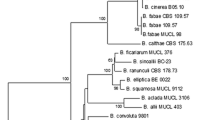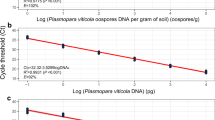Abstract
Real-time PCR was used to detect and quantify Verticillium dahliae and to assess the susceptibility of four Capsicum annuum cultivars (Luesia, Padrón, SCM331 and PI201234) and the Capsicum chinense cv. C118 to this pathogen. The symptoms which developed after infection included stunting and yellowing, and were more acute in the cv. SCM331, which also suffered defoliation in later stages of the disease and in C118, which suffered severe stunting. Quantification of the pathogen DNA in roots 23 and 34 days post-inoculation (dpi) revealed that there were significantly higher amounts of Verticillium dahliae DNA in C118 than in the other cultivars, followed by SCM331, Padrón and PI201234. The lowest amounts of fungal DNA in roots were found in Luesia. In hypocotyls, the highest amounts of fungal DNA were found in SCM331, while Luesia, Padrón and PI201234 had much lower amounts, and C118 had intermediate levels. When a compatible versus an incompatible system was studied, using the near-isogenic tomato lines LA3030 (susceptible) and LA3038 (resistant to V. dahliae), we were able to detect fungal DNA in both lines. As expected, the fungus/plant DNA ratio was lower in LA3038 than in LA3030 and it decreased with time in LA3038. The amount of Verticillium dahliae DNA in the roots of LA3030 remained constant between days 23 and 34 post-inoculation, but increased 10-fold in collars. Finally, when real-time PCR was applied as a diagnostic method to samples from pepper plants, soil and water collected from farms in northwest Spain, we were able to detect V. dahliae DNA in these samples even when symptoms of the disease were not evident.



Similar content being viewed by others
References
Barriuso J, Gil Ortega, R., & Palazón C (1992) Influence of temperature on the expression of partial resistance in pepper after artificial inoculation with Verticillium dahliae Kleb. In: Proceedings of the VIII Meeting on Genetics and Breeding on Capsicum and Eggplant, Rome, Italy (pp. 201–204).
Barriuso, J., Palazón, C., Gil Ortega, R., & Delgado, I. (1989). Characterization of Verticillium dahliae Kleb. isolates on a set of Capsicum spp. Capsicum Newsletter, 11, 37–38.
Bhat, R. G., Smith, R. F., Koike, S. T., Wu, B. M., & Subbarao, K. V. (2003). Characterization of Verticillium dahliae isolates and wilt epidemics of pepper. Plant Disease, 87, 789–797.
Böhm, J, Hahn, A., Schubert, R., Bahnweg, G., Adler, N., Nechwatal, J., Oehlmann, R., & Obwald, W. (1999). Real-time quantitative PCR. Determination in isolate spores of the mycorrhizal fungus Glomus mosseae and monitoring of Phytophthora infestans and Phytophthora citricola in the respective host plants. Journal of Phytopathology, 147, 409–416.
Bosland, P. W. (1994). Chile: History, cultivation, and uses. In G Charalambous (Eds.) Spices, herbs, and edible fungi (pp. 347–366). New York, NY, USA: Elsevier Publisher.
Bosland, P. W., & Lindsey, D. L. (1991). A seedling screen for Phytophthora root rot of pepper, Capsicum annuum. Plant Disease, 75, 1048–1050.
Cooper, R. M. (1984). The role of cell wall degrading enzymes in infection, damage. In R. K. S. Wood & G. J. Jellis (Eds.) Plant disease: Infection, damage and loss (pp. 13–27). Oxford, UK: Blackwell.
Dan, H., Ali-Khan, S. T., & Robb, J. (2001). Use of quantitative PCR diagnostics to identify tolerance and resistance to Verticillium dahliae in potato. Plant Disease, 85, 700–705.
Edwards, K., Johnstone, C., & Thompson, A. (1991). A simple and rapid method for the preparation of plant genomic DNA for PCR analysis. Nucleic Acids Research, 19, 1349.
Gachon, C., & Saindreman, P. (2004). Real-time PCR monitoring of fungal development in Arabidopsis thaliana infected by Alternaria brassicola and Botrytis cinerea. Plant Physiology and Biochemistry, 42, 367–371.
Gil Ortega, R., Palazón, C., & Barriuso, J. (1989). Búsqueda de resistencia a Verticillium dahliae en especies diferentes de Capsicum annuum. In Actas de las VII Jornadas de Selección y Mejora de Plantas Hortícolas, Badajoz, Spain (pp. 83–89).
Gil Ortega, R., Palazón, C., & Zueco, J. C. (1991). Genetics of resistance to Phytophthora capsici in the pepper line “SCM-334”. Plant Breeding, 107, 50–55.
González-Salán, M. M., & Bosland, P. W. (1992). Sources of resistance to Verticillium wilt in Capsicum. Euphytica, 59, 49–53.
Hayden, K. J., Rizzo, D., Tse, J., & Garbeloto, M. (2004). Detection and quantification of Phytophthora ramorum from California Forest using real-time polymerase chain reaction assay. Phytopathology, 94, 1075–1083.
Heale, J. B. (1988). Verticillium spp., the cause of vascular wilts in many species. In: J. H. Andrews & I. C. Tommerup (Eds.) Advances in Plant Pathology (pp. 291–312). London, UK: Academic Press Inc.
Hu, X., Nazar, R. N., & Robb, J. (1993). Quantification of Verticillium biomass in wilt disease development. Physiological and Molecular Plant Patholology, 42, 23–36.
Kawchuk, L. M., Hachey, J., Lynch, D. R., Kulcsar, F., van Rooijen, G., Waterer, D. R., Robertson, A., Kokko, E., Byers, R., Howard, R. J., Fischer, R., & Prüfer, D (2001). Tomato Ve disease resistance genes encode cell surface-like receptors. Proceedings of the National Academy of Sciences of the USA, 98, 6511–6515.
Kong, P., Hong, C., Jeffers, S. N., & Richardson, P. A. (2003). A specie-specific polymerase chain reaction assay for a rapid detection of Phytophthora nicotiana in irrigation water. Phytopathology, 93, 822–831.
Li, K. N., Rouse, D. I., Eyestone, E. J., & German, T. L. (1999). The generation of specific DNA primers using random amplified polymorphic DNA and its application to Verticillium dahliae. Mycological Research, 103, 1361–1368.
Martin, R. R., James, D., & Levesque, C. A. (2000). Impact of molecular diagnostic technologies on plant disease management. Annual Review of Phytopathology, 38, 207–239.
Mercado-Blanco, J., Collado-Romero, M., Parrilla-Araujo, S., Rodríguez-Jurado, D., & Jiménez-Díaz (2003). Quantitative monitoring of colonization of olive genotypes by Verticillium dahliae pathotypes with real-time polymerase chain reaction. Physiological and Molecular Plant Pathology, 63, 91–105.
Nazar, R. N., Hu, X., Schmidt, J., Culham, D., & Robb, J. (1991). Potential use of PCR-amplified ribosomal intergenic sequences in the detection and differentiation of Verticillium wilt pathogens. Physiological and Molecular Plant Pathology, 39, 1–11.
Norusis, M. J., & SPSS Inc. (1990). SPSS advanced statistics user’s guide. SSPS Inc, Chicago, IL, USA.
Novo, M., Pomar, F., Gayoso, C., & Merino, F. (2006). Cellulase activity in isolates of Verticillium dahliae differing in aggressiveness. Plant Disease, 90, 155–160.
Palazón, C., & Palazón, I. (1989). Estudios epidemiológicos sobre la “tristeza” del pimiento en la zona del valle medio del Ebro. Boletín de Sanidad Vegetal Plagas, 15, 233–262.
Palazón, C., Gil, R., & Palazón, I. (1978). La "tristeza o seca del pimiento. Estado actual del problema. ITEA, 32, 56–62.
Palloix, A., Pochard, E., Phaly, P., & Daubèze, A. M. (1990). Recurrent selection for resistance to Verticillium dahliae in pepper. Euphytica, 47, 79–89.
Pegg, G. F. (1974). Verticillium diseases. Review of Plant Pathology, 53, 157–182.
Platt, H. W., Mahuku, G. S., Maxwell, P., & MacLean, V. (2000). Detection techniques for research on Verticillium species in potato soils. In E. C. Tjamos, R. C. Rowe, J. B. Heale & D. R. Fravel (Eds.) Advances in Verticillium research and disease management (pp. 140–143). Saint Paul, MN, USA: APS Press.
Pomar, F., Bernal, M. A., Collar, J., Díaz J, Caramelo, C., Gayoso, C., Novo, M., Prego, C., Saavedra, A., Silvar, C., & Merino, F. (2001). A survey of “tristeza” of pepper in Galicia and the fungal pathogens causing the disease. Capsicum & Eggplant Newsletter, 20, 90–93.
Pomar, F., Novo, M., Bernal, M. A., Merino, F., & Ros Barceló, A. (2004). Changes in stem lignins (monomer composition and cross–linking) and peroxidase are related with the maintenance of leaf photosynthetic integrity during Verticillium wilt in Capsicum annuum. New Phytolologist, 163, 111–123.
Qi, M., & Yang, Y. (2002). Quantification of Magnaporthe grisea during infection of rice plants using real-time polymerase chain reaction and Northern blot/phosphoimaging analyses. Phytopathology, 92, 870–876.
Rozen, S., & Skaletsky, H. J. (2000). Primer3 on the WWW for general users and for biologist programmers. In S. Krawetz & S. Misener (Eds.) Bioinformatics methods and protocols: Methods in molecular biology (pp. 365–386). Totowa, NJ, USA: Humana Press.
Saavedra, A. M., Díaz, J., & Merino, F. (2003). Virulence of different isolates causing Verticillium wilt of pepper in the Padron region. Spanish Journal of Agricultural Research, 1, 53–57.
Shena, L., Nigro, F., Ipolito, A., & Gallitelli, D. (2004). Real-time quantitative PCR: A new technology to detect and study phytopathogenic and antagonistic fungi. European Journal of Plant Pathology, 110, 893–908.
Silvar, C., Díaz, J., & Merino, F. (2005a). Real-time polymerase chain reaction quantification of Phytophthora capsici in different pepper genotypes. Phytopathology, 95, 1423–1429.
Silvar, C., Duncan, J. M., Cooke, D. E. L., Williams, N. A., Díaz, J., & Merino, F. (2005b). Development of specific PCR primers for identification and detection of Phytophthora capsici Leon. European Journal of Plant Pathology, 112, 43–52.
Van de Graaf, P., Lees, A. K., Cullen, D. W., & Duncan, J. M. (2003). Detection and quantification of Spongospora subterranea in soil, water and plant tissues samples using real-time PCR. European Journal of Plant Pathology, 151, 577–583.
Vandermark, G. J., & Baker, B. M. (2003). Quantifying Phytophthora medicans in susceptible and resistant alfalfa with a real-time fluorescent PCR. Journal of Phytopathology, 151, 577–583.
Volossiouk, T., Robb, E. J., & Nazar, R. N. (1995). Direct DNA extraction for PCR mediated assays of soil organisms. Applied and Environmental Microbiology, 61, 3972–3976.
Winton, L. M., Stone, J. K., Watrud, L., & Hansen, E. M. (2002). Simultaneous one-tube quantification of host and pathogen DNA with real-time polymerase chain reaction. Phytopathology, 92, 112–116.
Acknowledgements
This work was supported by grants from XUGA (PDIDIT0RAG10301PR) and INIA (RTA04-065-2). We are greatly indebted to Silvia Saavedra for her skilful technical work. The technical assistance of José Antonio Vilar and Fernanda Rodríguez Fariña is gratefully acknowledged. We thank Dr Ros Barceló for his critical review.
Author information
Authors and Affiliations
Corresponding author
Rights and permissions
About this article
Cite this article
Gayoso, C., de Ilárduya, O.M., Pomar, F. et al. Assessment of real-time PCR as a method for determining the presence of Verticillium dahliae in different Solanaceae cultivars. Eur J Plant Pathol 118, 199–209 (2007). https://doi.org/10.1007/s10658-007-9134-8
Received:
Accepted:
Published:
Issue Date:
DOI: https://doi.org/10.1007/s10658-007-9134-8




